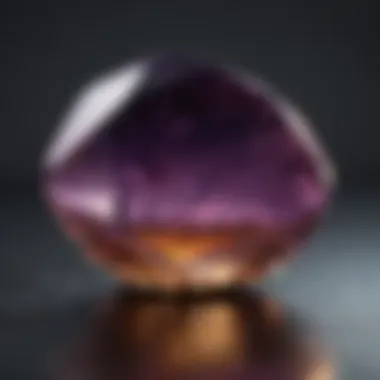Mastering the Art of Stone Polishing: An In-Depth Tumbler Guide


Rock and Fossil Identification
Stone polishing begins with a profound understanding of the rocks and fossils being worked on. Different types of rocks and fossils exhibit unique characteristics that determine their final appearance after the polishing process. As a rock and fossil enthusiast, it is essential to be well-versed in identifying these key features. Utilizing specialized tools for identification, such as magnifying glasses and hardness testing kits, can significantly aid in accurately categorizing rocks and fossils.
Collecting Tips and Techniques
To embark on a successful stone polishing journey, mastering collecting practices is paramount. Essential tips include identifying prime locations for rock and fossil collection, ensuring adherence to legal regulations, and applying environmentally conscious techniques during excavation. Properly extracting specimens without causing damage is crucial to preserving the integrity and aesthetic appeal of the rocks and fossils being collected.
Preservation and Display
After the meticulous process of stone polishing, preserving the beauty and quality of the rocks and fossils becomes a top priority. Employing effective preservation techniques, such as sealing with appropriate coatings or storing in controlled environments, can prolong the lifespan of polished stones. Innovative display ideas add an artistic flair to showcasing the intricacies of the polished rocks and fossils, creating visually compelling arrangements that captivate attention.
Geological Insights
Exploring the geological aspects of rocks and fossils enhances the appreciation for these natural wonders. Understanding the formations and processes that led to the creation of specific rocks and fossils reveals the fascinating history encapsulated within them. Delving into the geological significance and historical value of certain specimens sheds light on notable discoveries in the field, providing a deeper insight into the Earth's captivating journey through time and evolution.
Introduction to Stone Polishing
Stone polishing is a meticulous craft that entails enhancing the aesthetic appeal and durability of stones through precision techniques. In the world of lapidary arts, understanding the intricacies of stone polishing is paramount for unlocking the innate beauty of various gemstones and minerals. This section delves into the fundamental concepts and techniques that form the backbone of stone polishing, shedding light on its significance in the realm of rock and fossil collecting.
Understanding the Basics of Stone Polishing
Definition of stnoe polishing
Stone polishing, comprising processes like grinding, shaping, and buffing, aims to achieve a smooth, shiny surface on stones. This procedure accentuates the natural colors and patterns of stones, elevating their visual allure. The precision and finesse involved in stone polishing make it a preferred method for transforming raw stones into exquisite pieces of art. The consistency and luster achieved through stone polishing add value to gemstones and fossils.
History of stone polishedio techinuqes
The evolution of stone polishing techniques traces back centuries, with ancient civilizations like the Egyptians and Greeks pioneering methods to refine stones. Over time, advancements in technology and machinery revolutionized the stone polishing process, making it more efficient and accessible. Understanding the historical context of stone polishing provides insight into the heritage and innovation that have shaped modern lapidary practices. By exploring traditional techniques alongside contemporary approaches, stone polishers can merge time-honored wisdom with cutting-edge tools.
Significance of Using a Tumbler
Advantages of using a tmuber for stnoe polishing
Utilizing a tumbler for stone polishing offers various advantages, including uniformity in polishing results and decreased manual labor. Tumblers ensure a consistent finish on multiple stones simultaneously, saving time and effort for lapidaries. The gentle tumbling action minimizes the risk of damage to delicate stones, making it an ideal choice for polishing a diverse range of gems and minerals efficiently.


Differences betwene hand-polishnig and tumbling
The key distinction between hand-polishing and tumbling lies in the level of automation and consistency. While hand-polishing allows for greater precision and customization, tumbling streamlines the process for mass production. Hand-polishing caters to intricate detailing and individual stone requirements, whereas tumblers excel in providing a standardized polish across batches of stones. Balancing these two methods can optimize efficiency and quality in stone polishing projects.
Overview of Tumbler Types
Rotary tmluers
Rotary tumblers operate by constantly rotating a barrel to abrade stones against each other, resulting in smooth surfaces. This tumbling action simulates natural erosion over extended periods, gradually polishing stones to a high sheen. The simplicity and affordability of rotary tumblers make them popular among hobbyists and beginners in the lapidary field, offering a foundational step into the world of stone polishing.
Vibratory tmublers
In contrast, vibratory tumblers employ rapid vibrations to polish stones, providing quicker results than rotary tumblers. The vibratory motion creates friction between stones and abrasives, expediting the polishing process while preserving the stone's shape and integrity. Vibratory tumblers are preferred for hard stones that require aggressive polishing action and reduced tumbling duration.
Choosing the right tmluer for specific stones
Selecting the appropriate tumbler depends on factors like stone hardness, desired finish, and batch size. Understanding the unique properties of different tumblers, such as barrel capacity and rotational speed, allows lapidaries to tailor their polishing approach to specific stones. By matching stone characteristics with tumbler capabilities, artisans can optimize the polishing process for superior results and efficient workflow.
Choosing the Right Stones for Polishing
When delving into the art of stone polishing with a tumbler, one of the pivotal decisions is choosing the right stones. This section delves into the intricate process of selecting stones that are compatible with tumbling, ensuring the most favorable outcomes. The importance of this topic lies in the foundation it sets for the entire polishing journey. By selecting suitable stones, enthusiasts can optimize the tumbling process, leading to stunningly polished results. Factors such as hardness, texture, and composition play a pivotal role in determining the stones' suitability for tumbling. Choosing the right stones not only affects the final outcome but also impacts the efficiency and effectiveness of the tumbling process.
Types of Stones Suitable for Tumbling
Hard vs. soft stones
In the realm of stone tumbling, the classification of stones into hard and soft categories holds immense significance. Hard stones, such as agate or jasper, offer durability and are capable of withstanding the rigors of the tumbling process. On the other hand, soft stones like calcite or fluorite are more prone to abrasion but yield smooth finishes. The choice between hard and soft stones depends on the desired outcome – hard stones for a glossy finish and soft stones for a polished sheen. Understanding the characteristics of hard and soft stones enables enthusiasts to make informed decisions based on their polishing goals.
Common types of stones for beginners
For novices venturing into the world of stone polishing, certain types of stones serve as ideal starting points. Common beginner stones like quartz or obsidian are popular due to their forgiving nature during the tumbling process. They exhibit consistent hardness levels and respond well to polishing treatments, making them suitable choices for rookies. These stones present minimal challenges, allowing beginners to hone their tumbling skills and achieve satisfactory polishing results. Engaging with common stones for beginners not only facilitates the learning process but also instills confidence in individuals embarking on their stone polishing journey.
Preparing Stones for the Tumbling Process
Cleaning and inspecting stones
Prior to initiating the tumbling process, thorough cleaning and inspection of stones are essential steps to ensure optimal results. Cleaning removes impurities and contaminants that may interfere with the polishing process, enhancing the stones' aesthetics. Inspecting stones helps identify any defects or irregularities that could affect the tumbling outcome. By meticulously cleaning and inspecting stones, enthusiasts set the stage for a successful tumbling session, enhancing the overall efficiency of the process.


Applying pre-polish treatments
A critical aspect of preparing stones for tumbling involves applying pre-polish treatments to enhance their polishing potential. These treatments, ranging from abrasives to degreasers, aid in smoothing rough surfaces and priming stones for the tumbling stages ahead. Applying pre-polish treatments not only expedites the polishing process but also improves the clarity and luster of the final polished stones. By incorporating these treatments into the preparation phase, enthusiasts can elevate the quality of their polished stones and achieve superior results in the tumbling process.
Tumbling Techniques and Best Practices
When delving into the realm of stone polishing, the significance of understanding Tumbling Techniques and Best Practices cannot be overstated. This section serves as the backbone of the entire process, offering essential insights and methodologies for achieving impeccable results. A meticulous approach to Tumbling Techniques and Best Practices is crucial, as it directly impacts the outcome of the stone polishing endeavor. By focusing on specific elements such as the grinding stages and polishing techniques, this segment aims to equip readers with the necessary knowledge to navigate the intricacies of stone tumbling effectively.
Steps in the Tumbling Process
- Coarse grinding stage
Coarse grinding stage
Exploring the Coarse grinding stage unveils a pivotal aspect of the stone polishing procedure. This initial phase is fundamental in reshaping the rough surface of the stone, laying the foundation for subsequent grinding stages. The key characteristic of the Coarse grinding stage lies in its ability to efficiently remove larger imperfections and achieve a uniform surface texture. Despite its abrasive nature, the Coarse grinding stage stands out as an indispensable choice in this article due to its capacity to expedite the initial shaping process while ensuring a consistent groundwork for further refinement.
- Medium and fine grinding stages
Medium and fine grinding stages
Transitioning to the Medium and fine grinding stages marks a crucial juncture in the tumbling process. These stages focus on refining the surface quality of the stones, gradually smoothing out imperfections and enhancing the overall appearance. The primary characteristic of the Medium and fine grinding stages revolves around their precision and meticulous detailing, which contribute significantly to the final polish of the stones. While these stages demand patience and attention to detail, their role in achieving a lustrous finish makes them a favored choice in this article for delivering aesthetically pleasing results.
- Final polishing stage
Final polishing stage
As the final chapter of the tumbling journey, the Final polishing stage holds the key to unlocking the true brilliance of the stones. This stage is dedicated to imparting a glossy sheen and impeccable smoothness to the surfaces, elevating the stones to a state of luminous perfection. The distinctive feature of the Final polishing stage lies in its ability to bring out the innate beauty and vibrancy of the stones, culminating in a stunning visual display. While this stage requires precision and finesse, its role in achieving a flawless polish renders it an indispensable choice for those seeking exquisite results.
Tips for Optimal Results
- Water and abrasive considerations
Water and abrasive considerations
Delving into Water and abrasive considerations sheds light on a critical aspect of the tumbling process. The interaction between water and abrasives plays a pivotal role in determining the efficiency and efficacy of the polishing stages. The key characteristic of Water and abrasive considerations lies in their influence on the overall polishing outcome, impacting the smoothness and vibrancy of the stones. By carefully balancing the ratio of water to abrasives, enthusiasts can optimize the tumbling process and achieve superior results. While these considerations offer immense benefits in enhancing the final polish, it is essential to remain mindful of their inherent complexities and potential challenges.


- Monitoring tumbling progress
Monitoring tumbling progress
As the stones undergo the tumbling process, Monitoring tumbling progress emerges as a critical practice for ensuring optimal results. This vigilant oversight enables individuals to track the transformation of the stones, identifying any issues or irregularities along the way. The key characteristic of Monitoring tumbling progress lies in its role as a quality control measure, allowing for adjustments to be made in real-time to enhance the polishing outcomes. By actively monitoring the tumbling progress, enthusiasts can fine-tune the process and achieve consistent results, leading to a superior finish. While this practice offers valuable insights into the polishing journey, it requires a keen eye for detail and a proactive approach to problem-solving.
Post-Tumbling Care and Display
Post-tumbling care and display play a crucial role in the overall stone polishing process, ensuring that the polished stones retain their pristine beauty and durability. It is essential to understand the methods and techniques required to clean and dry stones effectively after the tumbling process. By following proper care and display practices, collectors can showcase their polished stones with pride while preserving them for the long term.
Cleaning and Drying Stones
Methods for cleaning post-tumbled stones
Cleaning post-tumbled stones is a meticulous task that involves removing any residues left from the tumbling process. Various methods can be utilized, such as rinsing the stones in warm soapy water, scrubbing them gently with a soft brush, or using specialized stone cleaners. Each method has its advantages and considerations, depending on the type of stones being polished. For instance, softer stones may require a gentler cleaning approach to avoid causing damage to the polished surface. It is crucial to select a cleaning method that effectively removes any debris or polishing compounds while safeguarding the stone's integrity.
Importance of proper drying
Proper drying of polished stones is paramount to prevent water spots and ensure a flawless finish. After cleaning, the stones should be thoroughly dried using a clean, soft towel or a gentle stream of air. Adequate drying time is necessary to eliminate any moisture that could lead to dulling or staining of the polished surface. Improper drying can degrade the appearance of the stones and compromise the hours spent on the tumbling process. By emphasizing the significance of proper drying techniques, collectors can maintain the quality and luster of their polished stones for an extended period.
Displaying Polished Stones
Creative display ideas
Creative display ideas add a touch of elegance to showcasing polished stones. From arranging them in unique patterns to integrating them into home decor, there are endless possibilities for displaying these natural treasures. Consider using decorative trays, shadow boxes, or glass jars to exhibit polished stones with style. Mixing and matching different stone sizes, shapes, and colors can create visually appealing displays that captivate viewers' attention. Incorporating lighting elements or contrasting textures further enhances the visual appeal of the polished stones.
Preservation techniques
Preservation techniques are essential for maintaining the integrity and beauty of polished stones over time. Applying a light coat of mineral oil or wax can help protect the stones from environmental factors and enhance their natural colors. Avoid exposing polished stones to direct sunlight or harsh chemicals, as these can cause fading or damage. Utilizing protective displays, such as glass domes or velvet-lined cases, can shield the stones from dust and abrasions while adding a touch of sophistication to the display. By implementing proper preservation techniques, collectors can enjoy their polished stones in pristine condition for years to come.
Conclusion
In comprehending the artistry encapsulated within stone polishing techniques, the concluding segment of this article contextualizes the broader narrative woven throughout each preceding section. By delving into the transformative essence of stone polishing, this conclusive discourse aims to elucidate the profound impact of this age-old practice on both the stones themselves and the practitioners involved. Beyond mere surface embellishment, stone polishing embodies a meticulous process that unlocks the innate splendor residing within each stone, elevating mundane rocks to veritable gems that speak of time and craftsmanship. Moreover, this rhetoric on the transformative nature of stone polishing underscores the need for patience, precision, and passion in every facet of the tumbler's journey, inviting enthusiasts to introspect on their role in preserving Earth's geological treasures for generations to come.
Appreciating the Art of Stone Polishing
Reflection on the transformative nature of stone polishing
At the core of embracing the essence of stone polishing lies the profound concept of metamorphosis - a fundamental embellishment of nature's raw offerings through human hands. Reflecting on the transformative nature of stone polishing allows enthusiasts to witness the morphing of rudimentary rocks into exquisite artworks, echoing the time-honored tradition of lapidary craftsmanship passed down through centuries. This contemplation not only serves as a tribute to the artisan's dedication but also fosters a deeper connection to the Earth's bounties, instilling a renewed sense of wonder and appreciation for the natural world's silent treasures. The act of reflection in stone polishing embodies a meditative pause amidst the whirl of modernity, offering a sanctuary of tranquility where art and nature converge in harmonious resonance.
Inspiration for further exploration in lapidary arts
Encouraging a spirit of perpetual exploration and discovery, the elucidation on inspirations for delving deeper into the realm of lapidary arts amplifies the creative potential inherent in every polished stone. Inspiring enthusiasts to transcend conventional boundaries, this discourse ignites a spark of curiosity that propels individuals towards uncharted territories in sculpting, cutting, and refining stones. By advocating for continuous learning and experimentation, the narrative on exploration strives to empower novices and aficionados alike to push the boundaries of their creativity, metamorphosing commonplace rocks into rare treasures that bear the mark of personalized ingenuity. The invitation to explore further realms of lapidary arts not only broadens one's horizons but also fosters a culture of innovation and exploration, marking each polished stone as a testament to boundless human imagination and perseverance.







